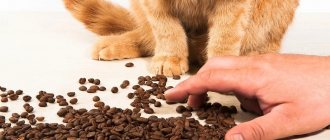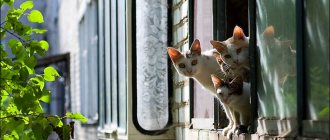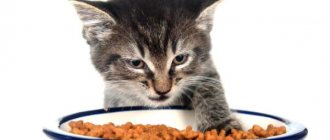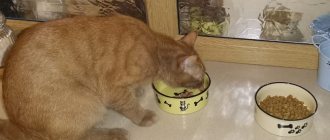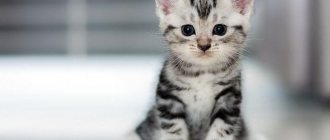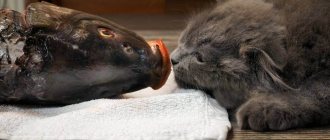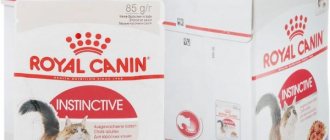Feed quality
Food, including dry food, is made from meat, but there is no way to preserve all its properties forever. Dry diet granules are treated with vitamin E; this is a useful and reliable preservative, but its validity period is limited and is approximately equal to the shelf life of the feed. Then the fats in the “drying” begin to decompose. The cat hears an unpleasant odor, feels a rancid taste and refuses to eat. The taste of canned food and spiders deteriorates in the same way after the expiration date. The answer to the question “why doesn’t the cat eat the food” can often be found in the “use before” line.
Cat won't eat new food
Even if you have chosen the ideal food for your cat, she may not immediately appreciate it. Indoor cats tend to experience stress from change, and sudden changes in diet put a strain on their digestive system. The situation becomes even more complicated when the new diet is not as varied as before - for example, if the pet needs to lose excess weight or prevent the development of allergies.
What to do. Study all the rules for switching to a new diet in advance. For this you will have to allocate at least seven days. During this period, you need to combine old and new food, monitor the temperature and texture of the food, and choose the right way to reward with treats.
Improper storage
Dry food loses flavor if kept outdoors. If your cat does not eat dry food that you bought in bulk, it may well be that the store did not carefully close the bag. For the same reason, you should not buy a year's supply for your pet: there is a high risk that you will have to throw away half of it. Opened canned food will only take a few hours at room temperature to become unusable. If you see that the cat has stopped eating wet food and has gone about his business, it is better to put the bowl with the leftovers in the refrigerator.
So, for what reasons can a cat refuse dry food?
1. Temporary loss of appetite due to illness, estrus, hot weather.
2. The bowl, as well as the place where it stands, is too dirty, and cats are clean animals.
3. Refuses due to problems with gums or teeth, as chewing granules is painful.
4. The animal had never tried dry food before, but ate natural products.
5. The cat also eats other food, as a result of which the feeling of hunger does not have time to manifest itself.
6. The food is of poor quality or contains unnecessary impurities that the animal does not like.
7. The product has deteriorated due to improper storage.
8. The cat is stressed, so she doesn’t eat, sleeps poorly, and hides in dark corners.
If, along with a reluctance to eat food, your mustachioed friend suffers from diarrhea, vomiting, and nasal discharge, then he is clearly sick. In this situation, you should definitely consult a veterinarian.
Cats don't eat, they feast on food. Make sure you don't get bored with the food
Another common reason why a cat has stopped eating dry food may be that the owners always offer the same taste. Try eating your favorite food three times a day for a month. Will it remain as desired and loved? What if you eat like this for a whole year? Most often, cats don’t eat, but treat themselves little by little. If your pet is tired of dry food, different flavors should be alternated .
Fortunately, now cat food is packaged in hermetically sealed bags; it will not spoil after opening the package.
It is also a good idea to diversify the diet by introducing wet food. After all, owners often accustom their animals to dry food, considering it the only complete source of all necessary substances. But this is a mistaken opinion. Pets always need additional sources of vitamins, as well as fresh grass to remove ingested hair from the body.
This is not the food
As we said, the cat's olfactory system reacts to animal proteins and fats in food, sending signals to the brain that this is the most suitable food for them. If dry food is poor in meat components, and vegetable fats are used instead of animal fats, then the cat may well refuse to eat it. After all, in nature cats do not eat grain, vegetables, mushrooms and nuts, and in most cases they only sniff flowers and grass and pass by. And even hunger doesn’t stop them from holding on tightly to their eating habits!
Therefore, cat food, of course, should consist primarily of meat rather than grain products, and then your pet will eat it much more willingly. In general, the advice is simple - change the food to one that meets the biological needs of cats as predators.
Stabilize your condition
Decreased appetite in pets with various diseases is common.
This may happen due to:
- underlying disease
- side effects from medications
- stress
- weaknesses
The cat may completely lose its appetite, but most likely it will reduce its food intake or change its food preferences.
If there is a possibility that your pet may be experiencing nausea, discuss a solution to the problem with your veterinarian. It's difficult to get your cat to eat well if she's feeling nauseous.
Changing food during an exacerbation of the disease can lead to the fact that the cat associates the new food with poor health and refuses it in the future.
By improving your pet's well-being, you can more comfortably transfer him to a therapeutic diet.
How to train a cat to eat what they give?
The taste and smell of food is of great importance to cats. Therefore, when you switch your pet to a new type of food or a different brand of food, it is better to act gradually, rebuilding the diet over the course of a week. First, no more than 20% of the portion is replaced with new food. Then every day they increase its share, bringing it to 100%.
The cat feels the familiar aroma and is more willing to start eating. In addition, gradual changes in diet protect your pet from digestive problems during the adaptation period.
Unfortunately, this “canonical” method does not work with picky cats. Even with an almost homogeneous mass of food, they are able to discard small particles that they do not like. As a result, the granules of the new food remain in the bowl, and the animal walks around hungry and dissatisfied. Well, we'll have to resort to more drastic measures.
What should the owner do?
The response directly depends on the cause of poor appetite. After finding out, you will have to eliminate the factors that irritate your pet, choose another feeding option, or take time to accustom him to unfamiliar food.
Determining the cause of feed rejection
If you detect alarming symptoms indicating the presence of pathology, you should not put pressure on the animal, forcing it to eat against its desire. In this case, simply contact your veterinarian. After treatment, your appetite will return on its own.
If your cat doesn’t eat dry food well, not because of illness, consider the specific situation:
- Loss of smell. With proper care, a mild cold will quickly go away on its own. If the olfactory function has disappeared due to old age, then it makes sense to switch to natural products with more pronounced odors.
Why does my cat no longer eat the food he used to eat?
Contents hide
Sometimes it happens that a pet does not want to eat its usual food, which just yesterday it was gobbling up both cheeks. Despite obvious hunger, the cat refuses to even approach the bowl. Do not rush to scold your pet and accuse him of being spoiled. The reasons for this behavior may be deeper.
The food has run out . Most often this happens with dry food. The attractive aroma of food is important to cats. Cats have trouble seeing in front of them, so they find food by smell. If the bowl does not smell of anything, it means it is empty and you should ask the person for food.
To prevent this from happening, keep bags and cans of food tightly closed. Also remember to check the expiration date. Expired food not only loses or changes its smell, but also becomes unsafe for your pet's health.
The owner forgets to wash the plate . Sometimes it happens the other way around: the bowl smells so bad that the cat simply doesn’t want to go near it. It is unlikely that the owners themselves would want to eat from dirty plates with flies circling over them.
Place food in a clean bowl, do not be lazy to throw out dried remains, wash and wipe the container dry. Compliance with the rules of hygiene promotes excellent appetite and prevents diseases, in particular intestinal disorders. Also, do not forget to wash the place where the bowl is – the tray or the floor.
Bad batch . The manufacturer may have a defect, for example, the food was prepared from low-quality raw materials. The recipe may also change. Cats are sensitive to smells and will immediately understand that food is spoiled or smells different, unusual. Cats are conservative, so they may not like the new consistency - too liquid or, conversely, too coarse and viscous.
Try buying food elsewhere or the same brand but with a different flavor. Don't forget about the expiration date. It is also not recommended to take loose dry food. Sellers pour it out of large bags in which the granules are stored for who knows how long. Perhaps the food simply dried out or, on the contrary, became damp and tasteless. Buy the same food, but in a sealed commercial package. The cat will probably like it more.
The cat is sick . Observe how your pet behaves at the bowl. If it fits, starts eating and immediately leaves, it is recommended to check the gums and teeth. Perhaps it hurts the cat to chew and that’s why he stops. If the teeth are in order, you should pay attention to the toilet: the cat may have indigestion.
The worst thing is if the cat ignores food altogether and sleeps a lot. Most often, this behavior indicates illness - from headaches to tumors. In this case, be sure to show the cat to the veterinarian.
The cat was spoiled . Yes, this can happen too. If, in addition to food, you like to feed from the table, give a lot of treats and delicacies, get ready for the periodic whims of your pet. The cat knows that in addition to the usual “banal” food there is a lot of other tasty things, and he will not refuse a tasty addition.
Try not to overfeed your pet with delicacies. Wean you off the table and eating from your hands immediately (or better not at all). The cat should eat food that is suitable for its age, health and weight. An unbalanced diet and “bite eating” lead to indigestion, allergies, weight gain and behavioral problems.
Photo source:
Is there a problem?
It also happens: the cat does not ignore the food completely, but eats only a few granules and moves away from the bowl. An inexperienced owner begins to worry, change food, rush from “drying” to “natural” and back again. In fact, there is no reason to worry: most domestic cats behave this way.
They practice the so-called buffet type of nutrition: during the day they make 10–15 approaches to the bowl, eating a little each time. Therefore, the main task of the owner is to comply with the daily allowance indicated on the food package, without overfeeding the animal and making sure that it eats normally. At the same time, it is important not to forget about drinking water: access to it should be around the clock.
I didn't really want to
It happens that cats who simply are not hungry refuse dry food, because in the morning they already begged for cheese, in the afternoon for a bag of cat treats, and in the evening they feasted on the leftovers of dinner. Is it any wonder that the dry food in the bowl remains untouched, and it seems to the owners that the cat does not eat it at all.
The solution to the problem is to completely eliminate any treats, both in the form of treats and kibble from the table, and not give the cat any other food except dry food. Hunger is not a big deal!
What to do in such cases?
Owners often prefer dry ready-made food not only because of ease of use. A high-quality store-bought product is balanced in composition, it includes vitamins, micro- and macroelements, and other useful substances necessary for the pet’s body.
For normal functioning, your pet may require holistic nutrition.
Some animals require a strict diet. Holistic food will fully satisfy the needs of your pet, while simultaneously providing its body with everything it needs. However, the animal does not always agree with the owner and goes on strike and refuses to eat dry food. In such situations, veterinarians advise soaking the product in water, milk or broth, then offering it to your four-legged friend. It is important to give your pet water regularly so that it is always available. In addition, you should constantly monitor the cleanliness of the dishes from which the cat eats, because if it is dirty, the animal may refuse to eat.
You should not suddenly switch from one type of food to another. It is recommended to gradually introduce a new product, adding a larger portion each time, until you can completely displace the usual food from the menu. In addition, veterinarians do not advise frequently changing brands of manufacturers. It is better to choose food together with your doctor, taking into account the individual characteristics of the cat’s body.
